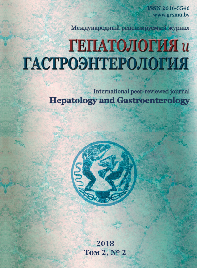HUMAN PARECHOVIRUS INFECTION IN PATIENTS WITH INFECTIOUS PATHOLOGY OF THE GASTROINTESTINAL TRACT AND MOLECULAR GENETIC CHARACTERISTIC OF CAUSATIVE AGENTS

Abstract
Background. Human parechoviruses (HPeVs) are widely distributed RNA viruses that are found in patients with infectious diseases of the digestive system. HPeV infection has not been diagnosed in the Republic of Belarus until now therefore information about its epidemiology was unavailable.
Objective is to study the results of detection and molecular typing of HPeV from patients with infectious pathology of the gastrointestinal tract.
Materials and methods. Clinical material from 276 patients with signs of gastroenteritis, collected in 2016–2018 years, was studied. Detection of HPeV was performed by RT-qPCR, while genotyping - by sequencing the VP1 gene.
Results. HPeV infection was detected in 4.7% of the examined patients. Sequence analyses showed that all HPeV isolates belonged to type 1.
Conclusion. HPeV makes a contribution to the etiological structure of intestinal viral infections registered in the Republic of Belarus. The population of HPeV-1 identified from the patients with gastroenteritis was characterized by considerable heterogeneity.
References
1. Olijve L, Jennings L, Walls T. Human Parechovirus: an Increasingly Recognized Cause of Sepsis-Like Illness in Young Infants. Clin. Microbiol. Rev. 2017;31(1):e00047-17. doi:10.1128/CMR.00047-17.
2. Parechovirus [Internet]. Available from: http://www icornaviridae.com/parechovirus/parechovirus.htm.
3. Shah G, Robinson JL. The particulars on parechovirus. Can. J. Infect. Dis. Med. Microbiol. 2014;25(4):186-188.
4. Strenger V, Diedrich S, Boettcher S, Richter S, Maritschnegg P, Gangl D, Fuchs S, Grangl G, Resch B, Urlesberger B. Nosocomial Outbreak of Parechovirus 3 Infection among Newborns, Austria, 2014. Emerg. Infect. Dis. 2016;22(9):1631-1634. doi: 10.3201/eid2209.151497.
5. Ljubin-Sternak S, Juretić E, Šantak M, Pleša M, Forčić D, Vilibić-Čavlek T, Aleraj B, Mlinarić-Galinović G. Clinical and molecular characterization of a parechovirus type 1 outbreak in neonates in Croatia. J. Med. Virol. 2011;83(1):137-141. doi: 10.1002/jmv.21848.
6. Aizawa Y, Suzuki Y, Watanabe K, Oishi T, Saitoh A. Clinical utility of serum samples for human parechovirus type 3 infection in neonates and young infants: The 2014 epidemic in Japan. J. Infect. 2016;72(2):223-232. doi: 10.1016/j.jinf.2015.10.010.
7. Biscaro V, Piccinelli G, Gargiulo F, Ianiro G, Caruso A, Caccuri F, De Francesco MA. Detection and molecular characterization of enteric viruses in children with acute gastroenteritis in Northern Italy. Infect. Genet. Evol. 2018;60:35-41. doi: 10.1016/j.meegid.2018.02.011.
8. Golitsyna LN, Zverev VV, Novikova NA, Fomina SG, Parfenova OV, Epifanova NV, Lukovnikova LB, Morozova OV, Ponomareva NV. Obnaruzhenie, osobennosti cirkuljacii i raznoobrazie parjehovirusov cheloveka v Nizhnem Novgorode [Prevalence, Features of Circulation, and Diversity of Human Parechoviruses in Nizhny Novgorod]. Voprosy virusologii [Problems of Virology]. 2013;58(2):29-33. (Russian).
9. Baumgarte S, de Souza Luna LK, Grywna K, Panning M, Drexler JF, Karsten C, Huppertz HI, Drosten C. Prevalence, Types, and RNA concentrations of human parechoviruses, including a sixth parechovirus type, in stool samples from patients with acute enteritis. J. Clin. Microbiol. 2008;46(1):242-248. doi:10.1128/JCM.01468-07.
10. Nix WA, Maher K, Johansson ES, Niklasson B, Lindberg AM, Pallansch MA, Oberste MS. Detection of all known parechoviruses by real-time PCR. J. Clin. Microbiol. 2008;46(8):2519-2524. doi: 10.1128/JCM.00277-08.
11. Nix WA, Maher K, Pallansch MA, Oberste MS. Parechovirus typing in clinical specimens by nested or semi-nested PCR coupled with sequencing. J. Clin. Virol. 2010;48(3):202-207. doi: 10.1016/j.jcv.2010.04.007.
12. Tamura K, Stecher G, Peterson D, Filipski A, Kumar S. MEGA6: Molecular Evolutionary Genetics Analysis version 6.0. Mol. Biol. Evol. 2013;30(12):2725-2729. doi: 10.1093/molbev/mst197.
13. Altschul SF, Gish W, Miller W, Myers EW, Lipman DJ. Basic local alignment search tool. J. Mol. Biol. 1990;215(3):403-410. doi: 10.1016/S0022-2836(05)80360-2.
14. Moe N, Pedersen B, Nordbø SA, Skanke LH, Krokstad S, Smyrnaios A, Døllner H. Respiratory Virus Detection and Clinical Diagnosis in Children Attending Day Care. PLoS One. 2016;11(7):e0159196. doi: 10.1371/journal.pone.0159196.
15. Ljubin-Sternak S, Marijan T, Ivković-Jureković I, Čepin-Bogović J, Gagro A, Vraneš J. Etiology and Clinical Characteristics of Single and Multiple Respiratory Virus Infections Diagnosed in Croatian Children in Two Respiratory Seasons. J. Pathog. 2016;2016:2168780. doi: 10.1155/2016/2168780.
16. Tapia G, Cinek O, Witsø E, Kulich M, Rasmussen T, Grinde B, Rønningen KS. Longitudinal observation of parechovirus in stool samples from Norwegian infants. J. Med. Virol. 2008;80(10):1835-1842. doi: 10.1002/jmv.21283.
17. Zhang DL, Jin Y, Li DD, Cheng WX, Xu ZQ, Yu JM, Jin M, Yang SH, Zhang Q, Cui SX, Liu N, Duan ZJ. Prevalence of human parechovirus in Chinese children hospitalized for acute gastroenteritis. Clin. Microbiol. Infect. 2011;17(10):1563-1569. doi: 10.1111/j.1469-0691.2010.03390.x.

















1.png)






